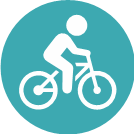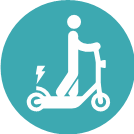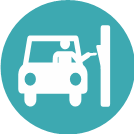Written by Drew Willsey, AICP
Macroeconomic Trends of COVID-19 and Their Potential Effects on Parking Behavior & Demand in the Mid-Term and Long Term
The emergence of the COVID-19 global pandemic in March 2020 has changed much of our daily lives and how we interact with our environments. After “stay-at-home” orders were put into place by numerous cities, counties, and states across the country, the economy suffered considerably. Within a matter of days, the freeways were nearly empty. The roads were nearly empty. And most of the parking lots were empty.
As summer continues, and the United States and Europe are only in the mid-stages of emerging from stay-at-home guidelines, there is increasing uncertainty about what lies ahead in the coming months and years for nearly every aspect of life and business. For the transportation planning industry, commonly-held facts about travel, mobility, habits, demand, and behavior have been called into question. This includes calling into question what the future holds, in both the short term and the long term, for parking planning and design. As the nation sorts through reams of data and conducts analysis trying to understand it all, the future of transportation, and therefore of parking, has doubtless been on the minds of every public planner and private developer.
As an industry leader in parking and transportation planning, Walker Consultants’ analysts and consultants have begun the process of considering what the future may hold for our industry. Of course, as of this writing, uncertainty remains very high. Nonetheless, it is essential that Walker attempt to at least establish a framework for thinking about and analyzing what may happen, and how the many variables that influence parking demand and travel behavior might vary relative to one another.
To that end, Walker has performed research on a wide array of macroeconomic factors that we feel are significant to the transportation planning and parking planning industry. This research encompasses a diversity of reliable and credible sources that go far beyond parking, with over 50 magazine articles, news stories, studies, and industry publications cited. Based on our research and analysis, a picture of what the future may hold, both in the mid-term and the long term, has begun to emerge as it relates to parking demand. This article sets out to illustrate that picture based on some key economic sectors and other areas of focus.
The data provided and conclusions drawn may change as the pandemic, and resulting understanding of its economic effects, continues to evolve. Walker will continue to monitor current developments through the rest of the year.
The macroeconomic factors that Walker performed research for have been grouped into nine different overall categories: retail & e-commerce, air travel & tourism, hotels, restaurants, universities & higher education, hospitals & healthcare, mode split & public transit, oil prices & driving, micromobility, and transportation network companies (TNCs).
For purposes of these conclusions, the “short term” means the remainder of 2020. The “mid-term” is the time period in which the pandemic situation begins to achieve permanent resolution, likely meaning whenever a vaccine becomes available and is disseminated across the population to such a degree that “herd immunity” is achieved. The “long term” means the period after the pandemic is over and related concerns are no longer playing a substantial role in affecting behavior or policy.
Retail & E-Commerce
- Parking demand may decline across the board for all brick-and-mortar retail depending on whether substantial increases in online retail sales volumes persist.
- Shopping malls and department stores may need less parking, presenting future opportunities for further repurposing and diversification of these land uses, which would necessitate right-sizing of parking supplies for those uses.
- However, declines in in-person retail activity may simply accelerate the trend of diversifying land uses at some shopping malls and retail centers, which will have the effect of offsetting decreases in parking demand for those establishments in the long term.
- Parking demand may remain steady or increase at key big box retail outlets and discount superstores.
- An increase in curbside pickup and “click and collect” services at many retailers may necessitate the implementation of curb management strategies and result in repurposing of some parking for those facilities to accommodate those services.
- If sale of goods and retail continue to migrate online, increased attention to curbside management and reallocation of travel lanes in the public right of way may be required in dense areas to accommodate increased delivery activity.
- While Black Friday as a shopping event may never be what it once was even in the long term, the importance of brick-and-mortar retail during the last week before Christmas, as well as the rising popularity of “click and collect” services, may mean that design day parking demand levels at many retail locations will remain unchanged or only see modest decreases.
- Long term decreases in retail parking demand may be offset by the diversification and repurposing of empty retail space to other uses, including residential uses.
Air Travel & Tourism
- Parking demand at US airports is likely to remain substantially lower into the long term, especially at continental airports that serve international travelers, such as SFO or JFK.
- Changes in travel habits, particularly for business travelers, as well as international travel restrictions, decreases in capacity, and fare increases may persist through the long term.
- Due to such changes, parking demand at airports may not return to pre-2020 levels for years as passenger volumes remain decreased.
- The decrease in parking demand resulting from decreased passenger volumes may be cushioned somewhat by a switch back to driving and parking, away from TNCs and from public transit.
- Parking demand decreases at close-in parking facilities typically owned and/or operated by the airport may be further cushioned by a decrease in demand for parking at off-airport facilities, as passengers may not wish to share a shuttle with others.
Office & Telecommuting
- Within the first few months of the pandemic, high percentages of both employees and employers have expressed satisfaction with working from home, as technology and Internet speeds have both matured to a point where they enable levels of productivity equal to and sometimes surpassing those seen while physically present at the office.
- With few to no negative effects on work productivity resulting from increased telecommuting, parking demand at office buildings may remain lower than it was pre-pandemic through the mid-term and long term.
- Prolonged social distancing measures may result in lower densities of employees per square foot, which would further decrease office parking demand for new office leases.
- The long-term likelihood of sustained increases in telecommuting may be further boosted by the associated cost savings for the employee, where not having to commute on a full-time basis can enable employees to live in less expensive areas that may be further away while also saving money on fuel.
- The employer can also realize cost savings from increased telecommuting due to the downsizing of the amount of office square footage needed, which would result in cheaper rent.
- However, depressed parking demand at some office buildings may be partially offset in the long term by the conversion of vacant office space to multi-family residential dwelling units, particularly in high-residential-demand cities and their respective high-density business districts where the sharing of parking resources is viable.
Hotels
- Parking demand at travel-orientated and budget hotels should normalize or even increase soon after the crisis has subsided.
- Parking demand at luxury hotels and hotels that serve patrons who flew into and out of their destination might take longer to normalize.
- Event parking demand at conference-orientated hotels may remain substantially decreased well into the future, even after conferences return, as the scope and scale of conferences is expected to be scaled back.
Restaurants
- Lasting increases in the number of people who plan on cooking at home more (especially when combined with increased telecommuting habits) could mean a decrease across the board in restaurant parking demand.
- Fast-casual restaurants may see persistent increases in parking demand.
- Increases in online ordering, delivery, and curbside pickup of food from all types of restaurants may persist, which may necessitate implementation of curbside management strategies and reallocation of self-parking to accommodate curbside pickup.
- While a long lasting or permanent decrease in restaurant visits may decrease parking demand in aggregate, the potential decrease of the number of restaurants that are in business after COVID-19 may have an offsetting effect, where total restaurant demand is distributed across fewer restaurants.
- Parking demand at fast food or drive-thru-orientated establishments is likely to remain unchanged or even increase.
Universities & Higher Education
- The degree to which online learning will affect parking demand in the long term is dependent on how many prospective students are willing to substitute the fully immersive in-person experience with an online learning experience.
- It is likely that at least some increases in online learning will persist, as more students may choose to learn in a mixed online/in-person environment as online learning becomes normalized.
- Parking demand at traditional university campuses that are more dorm-orientated is likely to be less affected than at commuter-orientated campuses or community colleges, as students at such facilities may be more likely to prefer online learning.
- The coming economic recession may result in persistent or accelerated decreased enrollment figures, which would decrease parking demand in a corresponding manner in the long term, all other trends being equal.
- The inability of new international students to enroll will further contribute to enrollment figure declines.
- Even without a prolonged recession, parking demand in the mid-term could be affected drastically unless the 2020 – 2021 school year carries on in a mostly traditional fashion.
- Decreased parking demand may be somewhat offset in the short and mid-terms by more students choosing to drive and self-park instead of utilizing campus shuttle systems and other alternative modes of transit.
- Decreases in demand and enrollment at schools that survive the pandemic may be further offset by the closure and consolidation of dozens of campuses across the country.
Hospitals & Healthcare
- In the short to mid-term, parking demand activities at hospitals is likely to remain abnormal.
- The need for temporary parking management plans may arise and persist throughout 2020, especially as a preventative/cautionary measure against a potential “second wave” of infection.
- Potential increases in outpatient and clinic parking demand resulting from a backlog may be offset by decreases in demand from in-person doctor’s office visits moving virtual.
- In the long term, there is likely to be a permanent decrease of parking demand at medical office buildings due to persistence and normalization of virtual visits for routine care and consultations.
- The sudden and prolonged inability of hospitals to operate valet parking for patients and visitors due to safety concerns may cause significant disruptions to hospital parking supplies, particularly at facilities that already rely on valet parking to help alleviate supply and demand imbalances.
Mode Split & Public Transit
- Decreased use in the short and mid-term of public transit due to increases in single-occupancy vehicle usage may partially offset decreases in parking demand across many land use categories resulting from economic recession or higher gas prices.
- Decreases in public transit demand may persist into the long term.
- In order to survive, public transit systems may have to evolve, especially in cities where transit usage was low to begin with.
- While fixed rail systems that operate in a hub-and-spoke model may remain more resilient as competitors to daily commuting, many fixed bus routes may change to an access-a-ride or call-n-ride format, where there are more, but smaller, options that could cover most or all of the first/last mile.
Oil Prices & Driving
- A longer pandemic may eventually cause a long-term gasoline supply shock, which could have the effect of reversing declines in public transit usage expected to occur in the short and mid-term as the imbalance could lead to persistently high gas prices that disincentivize driving.
- It is also likely that a supply shock does not materialize, which would keep gasoline prices low through the mid and long term and leave transit usage and TNC usage depressed, especially if the overall number of trips remains lower in aggregate compared to the pre-COVID baseline.
- The overall effects on vehicle miles travelled and parking demand of greater than $4 per gallon gasoline for an extended period of time in the United States is difficult to predict because it has never occurred.
- Though the physical structure and layout of most American cities would continue to make walking and biking non-viable modes of travel for most purposes, even in an environment of persistent high gas prices, such prices could accelerate the adoption rate of electric vehicles. An accelerated adoption rate for EVs would also accelerate the need for construction of new parking spaces or conversion of existing spaces that are equipped with electric charging infrastructure.
- However, persistently low fuel prices, along with the existing limitations of the electric vehicle charging infrastructure, may instead decelerate the adoption rate of electric vehicles relative to the pre-2020 trendline.
Micromobility
- If micromobility providers can survive the acute phases of the pandemic, they are likely to emerge stronger, with increases in utilization as well as improvements in profitability and overall viability.
- Increases in micromobility utilization could come mostly at the expense of mass transit, and not of automobiles, as micromobility is more compatible with social distancing.
- Because an increase in micromobility is likely to take away mostly from transit usage, and not from personal vehicle usage, such an increase would likely not decrease parking demand in most contexts.
- Increased micromobility utilization may necessitate additional space dedicated to parking/storing of scooters and bicycles in urban areas as well as in and around college campuses.
TNC’s & Rideshare
- Cheap and convenient rideshare services may lead to persistent reduced overall demand for public transit if TNCs can survive in the long term.
- It is unclear whether or not a majority of TNC users view TNCS as significantly less risky than public transit in terms of risk of contracting COVID-19.
- If rideshare users do not view TNCs as being significantly less risky, then it is likely that parking demand for fine dining, hotels, airports, and entertainment/events may increase back to pre-TNC levels as many potential TNC users choose to drive instead in the mid-term.
- It should be noted that the long-term financial viability of the major TNC operators remains uncertain, which should provide stakeholders caution when considering parking reductions as a function of expected TNC usage.

